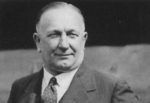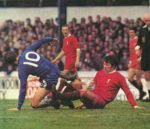How to watch football like an expert? Never try to analyse a game from the team you support live. You get too caught up in the fun and drama of football to actually see the game properly. If you want to analyse the team you support, I’d recommend watching the game in peace/as a fan, then get a replay of the 90 minutes to actually watch the game. You get the best of both worlds then; I don’t ever want to watch a City game(Author is a City fan) and be looking for invited pressing opportunities, I want to have a beer with some mates, have a sing song and watch the game.
Be aware of the opposition. In fact, to get a really good picture, go and watch their last couple of games and concentrate entirely on them. You need to know why your team have chosen the decisions that they have.
If you are just starting analyzing games properly, I’d recommend the stop-start technique. Essentially, you stop the video every ten seconds or so and try to understand what player is where, what runs are being made and think about why, etc. This will allow you to see the game at a much slower pace than it was played. Footballers have been working on decision making speed since birth and are experts in it. Ferguson in particularly runs problem solving drills near constantly and sees this as fundamental to his style of football. United’s players are not the technically best players in the world, I think we all accept this. The reason they are consistently at the top is not because Ferguson is some magical wizard; it’s because he trains his players to not only make decisions quicker than everybody else but to make the correct ones more often. Decision making is the root of Premier League football and the team that gets more of those split second decisions wrong will generally lose the game.
This is why numerous observed events happen; why goals are scored late in games more often after people’s concentration levels are low and their anxiety is high, effecting their ability to make decisions. Don’t ever forget that footballers are people and undergo the same psychological stress responses as the rest of us. It’s also why significantly worse teams can beat the best. It’s also why long ball football is successful (it requires a smaller amount of decisions but applied more often).
In fact, I should probably talk about analysis better. It’s a huge subject, akin to peeling an onion. Hopefully the following will go down a few layers but I can tell you that to go down to all layers would require thousands of pages. Football is a science, the one big thing that annoys me here is the simplistic view that people have about football. It’s so much deeper than people realize by watching it.
How to watch football
A couple of basics:
Football is a game of phases. Traditionally, we say three phases; the attacking phase, the defensive phase and the transitional phase. As you might imagine, it goes:
Defensive Transitional Attacking
There’s also possession-al phases that differ from both attacking, defending and transitional but another thing to ignore for the time being. Think of those three as the chapter headings in a book, of which there’s sub-headings breaking them into more detail.
Just to say, absolute formation does not exist; it’s a myth. There’s no such thing as playing 4-4-2 or 4-2-3-1. Every team has at least an attacking shape and a defensive shape. Some teams are more complex and have a shape for certain attacking phases, certain possession phases and certain defensive phases but for now we’ll ignore that. Nobody plays 3 at the back. That’s fucking stupid, you have 10 outfield players, why would you put 3 in defence? 3 at the back really means 3 in a transitional phase, 2 in an attacking phase, 5 in a defensive phase. All of formations are the same.
Your first job is to determine the attacking and defensive shapes of both your team and your opponent. Just for the sake of brevity, I’m going to call your opponent Norwich but it applies to everybody equally.
When Norwich have the ball in an attacking phase (and United(Imagine you are a United supporter) out of possession in a defensive phase), where are the players on the pitch? Stop and count. Now do the opposite for when United are in attacking phases and Norwich defending.
When Norwich have the ball in an attacking phase (and United(Imagine you are a United supporter) out of possession in a defensive phase), where are the players on the pitch? Stop and count. Now do the opposite for when United are in attacking phases and Norwich defending.
I’d recommend now that you pause the video, have a brew maybe and think through their respective shapes. The things you are looking for is:
Who are the hybrid players? (Players that are in one position in defensive phases but different ones in attacking phases and vice versa, at United I mean your fullbacks, your striker dropping off, your centre mid, etc). Hybrid players are a potential target in a transitional phase.
Where do natural overloads occur? An overload is where there are more players from one team in one area than another. An example might be Neville overlapping Beckham creating an overload in the opponent’s left back area. Another could be Giggs helping Rafael to close down Ronaldo thus creating an overload in their left wing slot. Any time somebody has more players in one area, it’s an overload.
An overload will also include a time when a player is in space of a position thus there’s 1 player there to the opponent’s 0.
You can be pretty confident after this that you’ve got a high level view of the game. Of course, you need to relook at this every few minutes and see who has moved to where and think about how this fits into the overall picture.
In analysing the shapes, you should also see exactly how many players are involved in each phase of play. Don’t be fooled here though; even players not immediately involved in one phase might have their own job to perform. Here I’m talking about things like Carrick “making himself the easy option” (forming the back shape) or “guarding the midfield” (preventative positioning). Just because they aren’t bombing forward does not mean that they don’t have a crucial role in an attacking phase and vice versa. Perhaps a spoiler but everybody apart from the CBs and the GK are involved in United’s attacking phase whilst all 11 are involved in the defensive phase including the forwards.
You will use this big picture to then look at the next categories; everything comes back to what you’ve learnt in this initial layer of the onion.
This post is sourced from a series of comments by Devineman on Reddit/Soccer









Recent Comments